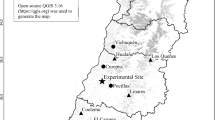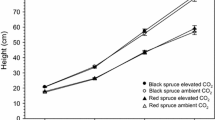Abstract
Suitability for production of woody floral stems in a pecan [Carya illinoinensis (Wangenh.) C. Koch] alley cropping was determined for nine shrub species in northwest Florida. Treatments included partial shade without root competition, partial shade with root competition, and full sun. Only three species had high rates of survival for all treatments throughout both years of the study: Callicarpa americana L. (American beautyberry), C. americana var. Lactea (white American beautyberry), and Crataegus marshallii Eggl. (parsley haw). For C. americana, plant growth index increased through time and was similar among the three treatments, indicating that this species grew equally well in sun or shade irrespective of root competition from the tree crop. C. americana var. Lactea had similarly high rates of survival and grew largest in partial shade without root competition (81.7 cm) compared to partial shade with root competition (67.2 cm) and full sun (57.0 cm). C. marshallii had 100 % survival in partial shade without root competition, with one mortality in partial shade with root competition (91.7 % survival) and one in full sun (91.7 % survival). Growth index did not increase over time and was similar among all three treatments. Other species tested had low rates of survival in all treatments throughout both years of the study and included: Ilex glabra L. (inkberry), Ilex myrtifolia Walt. (myrtle-leaf holly), Hydrangea paniculata Seibold var. ‘Tardiva’ (panicle hydrangea), Hydrangea quercifolia Bart. (oakleaf hydrangea), Lyonia lucida (Lam.) K. Koch, and Salix matsudana Koidz. F. tortuosa Rehd. (corkscrew willow). No species produced sufficient flowers, fruits or ornamental stems during this establishment period to allow a florist evaluation of the stems for use as woody floral stems.

Similar content being viewed by others
References
Allen SC, Jose S, Nair PKR, Brecke BJ, Nair VD, Graetz D, Ramsey CL (2005) Nitrogen mineralization in a pecan (Carya illinoensis K. Koch)–cotton (Gossypium hirsutum L.) alley cropping system in the southern United States. Biol Fertil Soils 41:28–37
Bachman J (2002) Woody ornamentals for cut flower growers. Appropriate technology transfer for rural areas. (ATTRA), July 2002
Brady NC, Weil RR (2002) The nature and properties of soils. Pierson Education Ltd, Upper Saddle River 215
Brakie M (2010) Plant fact sheet for American beautyberry (Callicarpa americana). USDA-Natural Resources Conservation Service, East Texas Plant Materials Center. Nacogdoches
Clough JM, Teeri JA, Tonsor SJ (1983) Photosynthetic adaptation of Solanum dulcamara L. to sun and share environments. Oecologia 60:348–352
Douglas GB, Bulloch BT, Foot AG (1996) Cutting management of willows (Salix spp.) and leguminous shrubs for forage during summer. New Zealand J Agric Res 39:175–184
Florida Natural Areas Inventory (FNAI) (2010) Guide to the natural communities of Florida: 2010 edition. Florida Natural Areas Inventory, Tallahassee
Gillespie AR, Jose S, Mengel DB, Hoover WL, Pope PE, Seifert JR, Biehle DJ, Stall T, Benjamin TJ (2000) Defining competition vectors in a temperate alleycropping system in the Midwestern USA: 1. Production physiology. Agroforest Syst 48:26–40
Gilman EF and Watson DG (1993) Hydrangea paniculata. University of FL Plant Fact Sheet FPS-298 Gainesville
Gilman EF and Watson DG (2006) Ilex myrtifolia, fact sheet ENH-458. Institute of Food and Agricultural Sciences, University of Florida, Gainesville
Hagan DL, Jose S, Thetford M, Bohn K (2009) Production physiology of three native shrubs intercropped in a young longleaf pine plantation. Agroforest Syst 76:283–294
Hagan DL, Jose S, Thetford M, Bohn K (2010) Partitioning of applied 15 N fertilizer in a longleaf pine and native woody ornamental intercropping system. Agroforest Syst 79:47–57
He WM, Dong M (2002) Physiological acclimation and growth response to partial shading in Salix matsudana in the Mu Us Sandland in China. Trees 17:87–93
Jose S, Gordon AM (2008) Ecological knowledge and agroforestry design. In: Jose S, Gordon AM (eds) Toward agroforestry design: an ecological approach. Springer, Dordrecht, pp 3–9
Jose S, Gillespie AR, Seifert JR, Biehle DJ (2000) Defining competition vectors in a temperate alley cropping system in the Midwestern USA 2 Competition for water. Agroforest Syst 48:41–59
Jose S, Gillespie AR, Pallardy SG (2004) Interspecific interactions in temperate agroforestry. Agroforest Syst 61:237–255
Josiah SJ, St-Pierre R, Brett H, Brandle JR (2004) Productive conservation: diversifying farm enterprises by producing specialty woody products in agroforestry systems. J Sustain Agric 23:93–108
Kuzovkina Y, Quigley M (2004) Selection of Willows for floral and stem quality and continuous production sequence in temperate North America. HortTechnology 14(3):415–419
Kuzovkina Y, Quigley M (2005) Willows beyond wetlands: uses of Salix L. species for environmental projects. Water Air Soil Pollut 162:183–204
Lusher W, Jackson J, Morgan K (2009) The Florida Automated Weather Network (FAWN): ten years of providing weather information to Florida growers. Florida Cooperative Extension Service, Institute of Food and Agricultural Sciences, University of Florida. Document SL 298
Monteith JL, Ong CK, Corlett JE (1991) Microclimatic interactions in agroforestry systems. Forest Ecol Manag 45:31–44
Nelson Gil (1996) The shrubs and woody vines of Florida. Pineapple Press, Sarasota
Osorio Rufino (2001) A gardner’s guide to Florida’s native plants. University Press of Florida, Gainesville
Takatsuki S (1986) Food habits of sika deer on Mt. Goyo Ecol Restor 16:257–263
Thetford M, Miller D, Smith K, Schneider M (2006) Container size and planting zone influence on transplant survival and growth of two coastal plants. HortTechnology 15:554–559
Thevathasan NV, Gordon AM (2004) Ecology of tree intercropping systems in the North temperate region: experiences from Ontario Canada. Agroforest Syst 61:257–268
Tilman D (1985) The resource ratio hypothesis of plant succession. Am Nat 125:827–852
Tilman D (1990) Mechanisms of plant competition for nutrients: the elements of a predictive theory of plant competition. In: Grace JB, Tilman D (eds) Perspectives on plant competition. Academic Press, San Diego, pp 117–141
Tobe John D (1998) Florida wetland plants: an identification manual. Rose Printing Company, Tallahassee
Wanvestraut RW, Jose S, Nair PKR, Brecke BJ (2004) Competition for water in a pecan (Carya illinoisensis K. Koch)- cotton (Gossypium hirsutum L.) alley cropping system in the southern United States. Agroforest Sys 60:167–179
Watson WT (2005) Influence of tree size on transplant establishment and growth. HortTechnology 15(1):118–122
Workman SW and Allen SC (2004) The practice and potential of agroforestry in the southeastern United States. Circular 1446, Florida Cooperative Extension Service, Institute of Food and Agricultural Sciences, University of Florida, p 49
Zamora DS, Jose S, Jones JW, Brecke BJ, and Ramsey CL (2008) Interspecific competition in a pecan-cotton alley-cropping system in the southern United States. In: Toward agroforestry design: an ecological approach. pp 86–99
Author information
Authors and Affiliations
Corresponding author
Additional information
Mack Thetford: Submitted in partial fulfillment of a M.S. theses requirement. This project supported in part by a United States Department of Agriculture Tropical Subtropical Agricultural Research—Caribbean Management Grant. Mention of a trademark, proprietary product, or vendor does not constitute a guarantee or warranty of the product by the Florida Agriculture Experiment Station and does not imply its approval to the exclusion of other products or vendors that also may be suitable.
Rights and permissions
About this article
Cite this article
Fletcher, E.H., Thetford, M., Sharma, J. et al. Effect of root competition and shade on survival and growth of nine woody plant taxa within a pecan [Carya illinoinensis (Wangenh.) C. Koch] alley cropping system. Agroforest Syst 86, 49–60 (2012). https://doi.org/10.1007/s10457-012-9507-7
Received:
Accepted:
Published:
Issue Date:
DOI: https://doi.org/10.1007/s10457-012-9507-7




